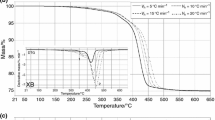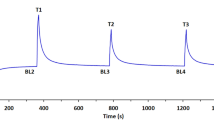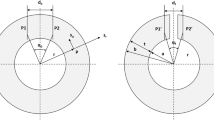Abstract
Thermal properties and degree of conversion (DC%) of two composite resins (microhybrid and nanocomposite) and two photo-activation methods (continuous and gradual) displayed by the light-emitting diode (LED) light-curing units (LCUs) were investigated in this study. Differential scanning calorimetry (DSC) thermal analysis technique was used to investigate the glass transition temperature (T g) and degradation temperature. The DC% was determined by Fourier transform infrared spectroscopy (FT-IR). The results showed that the microhybrid composite resin presented the highest T g and degradation temperature values, i.e., the best thermal stability. Gradual photo-activation methods showed higher or similar T g and degradation temperature values when compared to continuous method. The Elipar Freelight 2TM LCU showed the lowest T g values. With respect to the DC%, the photo-activation method did not influence the final conversion of composite resins. However, Elipar Freelight 2TM LCU and microhybrid resin showed the lowest DC% values. Thus, the presented results suggest that gradual method photo-activation with LED LCUs provides adequate degree of conversion without promoting changes in the polymer chain of composite resins. However, the thermal properties and final conversion of composite resins can be influenced by the kind of composite resin and LCU.



Similar content being viewed by others
References
Gatti A, Rastelli ANS, Ribeiro SJL, Messaddeq Y, Bagnato VS. Polymerization of photocurable commercial dental methacrylate-based composites. J Therm Anal Calorim. 2007;87:631–4.
Charton C, Falk V, Marchal P, Pla F, Colon P. Influence of T g, viscosity and chemical structure of monomers on shrinkage stress in light-cured dimethacrylate-based dental resins. Dent Mater. 2007;23:1447–59.
Hilton TJ. Can modern restorative procedures and materials reliably seal cavities? In vitro investigations. Part 1. Am J Dent. 2002;15:198–210.
St-Georges AJ, Wilder AD Jr, Perdigão J, Swift EJ Jr. Microleakage of Class V composites using different placement and curing techniques: an in vitro study. Am J Dent. 2002;15:244–7.
Briso AL, Mestrener SR, Delicio G, Sundfeld RH, Bedran-Russo AK, de Alexandre RS, Ambrosano GM. Clinical assessment of postoperative sensitivity in posterior composite restorations. Oper Dent. 2007;32:421–6.
Cunha LG, Alonso RCB, Neves ACC, de Goes MF, Ferracane JL, Sinhoreti MAC. Degree of conversion and contraction stress development of a resin composite irradiated using halogen and led at two c-factor levels. Oper Dent. 2009;34:24–31.
Rueggeberg F. Contemporary issues in photocuring. Compend Contin Educ Dent Suppl. 1999;25:S4–15.
Deb S, Sehmi H. A comparative study of the properties of dental resin composites polymerized with plasma and halogen light. Dent Mater. 2003;19:517–22.
Schneider LFJ, Consani S, Ogliari F, Correr AB, Sobrinho LC, Sinhoreti MAC. Effect of time and polymerization cycle on the degree of conversion of a resin composite. Oper Dent. 2006;31:489–95.
Caughman WF, Rueggeberg FA. Shedding new light on composite polymerization. Oper Dent. 2002;27:636–8.
Leonard DL. Critical appraisal: light-emitting-diode curing lights-revisited. J Esthet Restor Dent. 2007;19:56–62.
Yap AUJ, Seneviratne C. Influence of light energy density on effectiveness of composite cure. Oper Dent. 2001;26:460–6.
Halvorson RH, Erickson RL, Davidson CL. Energy dependent polymerization of resin-based composite. Dent Mater. 2002;18:463–9.
Peutzfeldt A, Asmussen E. Resin composite properties and energy density of light cure. J Dent Res. 2005;84:659–62.
Asmussen E, Peutzfeldt A. Polymerization contraction of resin composite vs energy and power density of light-cure. Eur J Oral Sci. 2005;113:417–21.
Calheiros FC, Kawano Y, Stansbury JW, Braga RR. Influence of radiant exposure on contraction stress, degree of conversion and mechanical properties of resin composites. Dent Mater. 2006;22:799–803.
Dewaele M, Asmussen E, Peutzfeldt A, Cristian Munksgaard E, Benetti AR, Finné G, Leloup G, Devaux J. Influence of curing protocol on selected properties of light-curing polymers: degree of conversion, volume contraction, elastic modulus, and glass transition temperature. Dent Mater. 2009;25:1576–84.
Benetti AR, Asmussen E, Munksgaard EC, Dewaele M, Peutzfeldt A, Leloup G, Devaux J. Softening and elution of monomers in ethanol. Dent Mater. 2009;25:1007–13.
Dewaele M, Truffier-Boutry D, Devaux J, Leloup G. Volume contraction in photocured dental resins: the shrinkage-conversion relationship revisited. Dent Mater. 2006;22:359–65.
Asmussen E, Peutzfeldt A. Two-step curing: influence on conversion and softening of a dental polymer. Dent Mater. 2003;19:466–70.
Soh MS, Yap AUJ. Influence of curing modes on crosslink density in polymer structures. J Dent. 2004;32:321–6.
Yap AU, Soh MS, Han TT, Siow KS. Influence of curing lights and modes on cross-link density of dental composites. Oper Dent. 2004;29:410–5.
Rastelli ANS, Jacomassi DP, Bagnato VS. Effect of power densities and irradiation times on the degree of conversion and temperature increase of a microhybrid dental composite resin. Laser Phys. 2008;18:1074–9.
Fróes-Salgado NRG, Pfeifer CSC, Francci CE, Kawano Y. Influence of photoactivation protocol and light guide distance on conversion and microleakage of composite restorations. Oper Dent. 2009;34:408–14.
Asmussen E, Peutzfeldt A. Influence of selected components on crosslink density in polymer structures. Eur J Oral Sci. 2001;108:282–5.
Asmussen E, Peutzfeldt A. Influence of pulse-delay curing on softening of polymer structures. J Dent Res. 2001;80:1570–3.
Tamareselvy K, Rueggeberg F. Dynamic mechanical analysis of two crosslinked copolymer systems. Dent Mater. 1994;10:290–7.
Rueggeberg FA, Erge JW, Mettenburg DJ. Polymerization depths of contemporary light curing units using microhardness. J Esthet Dent. 2000;12:340–9.
Vandewalle KS, Ferracane JL, Hilton T, Erickson RL, Sakaguchi RL. Effect of energy density on properties and marginal integrity of posterior resin composite restorations. Dent Mater. 2004;20:96–106.
Rastelli ANS, Jacomassi DP, Bagnato VS. Degree of conversion and temperature increase of a composite resin light cured with an argon laser and blue LED. Laser Phys. 2008;18:1570–5.
Lovell LG, Lu H, Elliott JE, Stansbury JW, Bowman CN. The effect of cure rate on the mechanical properties of dental resins. Dent Mater. 2001;17:504–11.
Anseth S, Bowman CN. Kinetic gelation model predictions of crosslinked polymer network microstructure. Chem Eng Sci. 1994;49:2207–17.
Groenewoud W. Characterization of polymers by thermal analysis. St Louis: Elsevier; 2001.
Witzel MF, Calheiros FC, Gonçalves F, Kawano Y, Braga RR. Influence of photoactivation method on conversion, mechanical properties, degradation in ethanol and contraction stress of resin-based materials. J Dent. 2005;33:773–9.
Obici AC, Sinhoreti MAC, Frollini E, Sobrinho LC, Goes MF, Henriques GEP. Monomer conversion at different dental composite depths using six light-curing methods. Polym Testing. 2006;25:282–8.
Soares LES, Liporoni PCS, Martin AA. The effect of soft-start polymerization by second generation LEDs on the degree of conversion of resin composite. Oper Dent. 2007;32:160–5.
Lu H, Stansbury JW, Bowman CN. Impact of curing protocol on conversion and shrinkage stress. J Dent Res. 2005;84:822–6.
Lopes LG, Franco EB, Pereira JC, Mondelli RFL. Effect of light-curing units and activation mode on polymerization shrinkage and shrinkage stress of composite resins. J Appl Oral Sci. 2008;16:35–42.
Ruyter IE, Oeysaed H. Composites for use in posterior teeth: composition and conversion. Biomed Mater Res. 1987;21:11–23.
Vogel BM, Mallapragada SK. Synthesis of novel biodegradable polyanhydrides containing aromatic and glycol functionality for tailoring of hydrophilicity in controlled drug delivery devices. Biomaterials. 2005;26:721–8.
Nomura Y, Teshima W, Tanaka N, Yoshida Y, Nahara Y, Okazaki M. Thermal analysis of dental resins cured with blue light-emitting diodes (LEDs). J Biomed Mater Res. 2002;63:209–13.
Bernardi MIB, Rojas SS, Andreeta MRB, Rastelli ANS, Hernandes AC, Bagnato VS. Thermal analysis and structural investigation of different dental composite resins. J Therm Anal Calorim. 2008;94:791–6.
Watts DC. Reaction kinetics and mechanics in photo-polymerised networks. Dent Mater. 2005;21:27–35.
Hofmann N, Markert T, Hugo B, Klaiber B. Effect of high intensity vs. soft-start irradiation on light-cured resin-based composites. Part II: hardness and solubility. Am J Dent. 2004;17:38–42.
Rueggeberg FA, Caughman WF, Curtis JW Jr. Effect of light intensity and exposure duration on cure of resin composite. Oper Dent. 1994;19:26–32.
Moraes LGP, Rocha RS, Menegazzo LM, de Araujo EB, Yukimoto K, Moraes JC. Infrared spectroscopy: a tool for determination of the degree of conversion in dental composites. J Appl Oral Sci. 2008;16:145–9.
Silikas N, Eliades G, Watts DC. Light intensity effects on resin-composite degree of conversion and shrinkage strain. Dent Mater. 2000;16:292–6.
Stansbury JW, Dickens SH. Determination of double bond conversion in dental resins by near infrared spectroscopy. Dent Mater. 2001;17:71–9.
Gauthier MA, Stangel I, Ellis TH, Zhu XX. A new method for quantifying the intensity of the C=C band of dimethacrylate dental monomers in their FTIR and Raman spectra. Biomaterials. 2005;26:6440–8.
Sustercic D, Cevc P, Funduk N, Pintar MM. Determination of curing time in visible-light-cured composite resins of different thickness by electron paramagnetic resonance. J Mater Sci Mater Med. 1997;8:507–10.
Morgan DR, Kalachandra S, Shobha HK, Gunduz N, Stejskal EO. Analysis of a dimethacrylate copolymer (BisGMA and TEGDMA) network by DSC and 13C solution and solid-state NMR spectroscopy. Biomaterials. 2000;21:1897–903.
Antonucci JM, Toth EE. Extent of polymerization of dental resins by differential scanning calorimetry. J Dent Res. 1983;62:121–5.
Imazato S, McCabe JF, Tarumi H, Ehara A, Ebisu S. Degree of conversion of composites measured by DTA and FTIR. Dent Mater. 2001;17:178–83.
Bouschilicher MR, Rueggeberg FA. Effect of ramped light intensity on polymerization force and conversion in a photoactivated composite. J Esthet Dent. 2000;12:328–39.
Emami N, Söderholm KJ. How light irradiance and curing time affect monomer conversion in light-cured resin composites. Eur J Oral Sci. 2003;111:536–42.
Rueggeberg FA. Determination of resin cure using infrared analysis without an internal standard. Dent Mater. 1994;10:282–6.
Halvorson RH, Erickson RL, Davidson CL. The effect of filler and silane content on conversion of resin-based composite. Dent Mater. 2003;19:327–33.
Bala O, Ölmez A, Kalayci S. Effect of LED and halogen light curing on polymerization of resin-based composites. J Oral Rehabil. 2005;32:134–40.
Turssi CP, Ferracane JL, Vogel K. Filler features and their effects on wear and degree of conversion of particulate dental resin composites. Biomaterials. 2005;26:4932–7.
Ferracane JL, Aday P, Matsumoto H, Marker VA. Relationship between shade and depth of cure for light-activated dental composite resins. Dent Mater. 1986;2:80–4.
Rojas SS, Frigo GJM, Bernardi MIB, Rastelli ANS, Hernandes AC, Bagnato VS. Thermal and structural properties of commercial dental resins light-cured with blue emitting diodes (LEDs). J Therm Anal Calorim. 2009. doi:10.1007/s10973-009-0521-6.
Acknowledgements
The authors would like to express their gratitude to the University of São Paulo-USP, Physics Institute of São Carlos, especially to the Optics and Cristal Growth and Ceramic Materials Groups for permitting us to use the equipments used in this study. Also, the authors would like to thank for 3M Espe Brazil for providing the composite resins and LCU used in this study. The authors owe their special thanks to Milko Javier Villarroel Cortes for the availability of the Bluephase® C8 (Ivoclar/Vivadent) LCU. This study was funded by CAPES and São Paulo State University-UNESP, and the Department of Restorative Dentistry, Araraquara School of Dentistry.
Author information
Authors and Affiliations
Corresponding author
Rights and permissions
About this article
Cite this article
Costa, S.X.S., Galvão, M.R., Jacomassi, D.P. et al. Continuous and gradual photo-activation methods: influence on degree of conversion and crosslink density of composite resins. J Therm Anal Calorim 103, 219–227 (2011). https://doi.org/10.1007/s10973-010-1018-z
Received:
Accepted:
Published:
Issue Date:
DOI: https://doi.org/10.1007/s10973-010-1018-z




